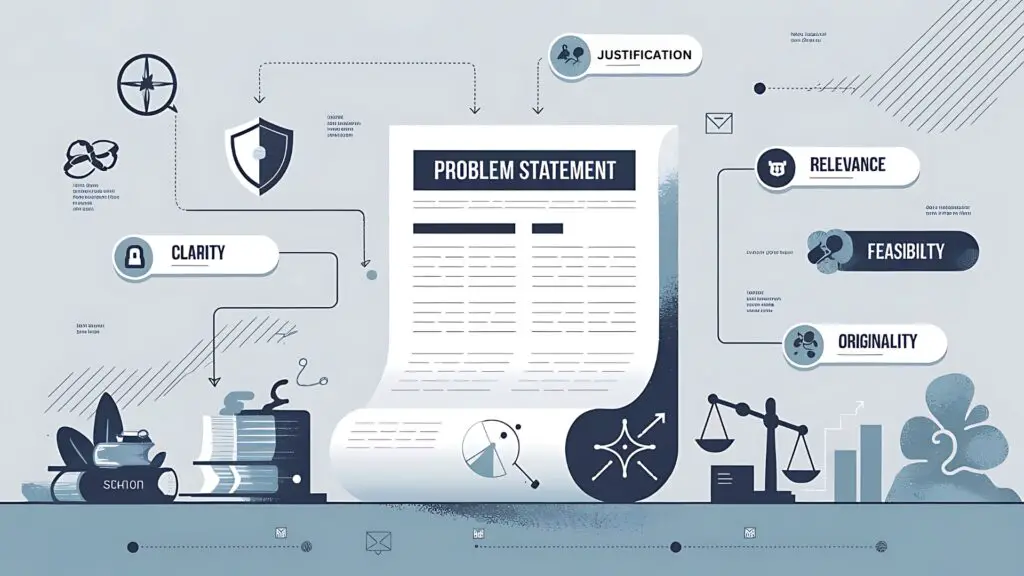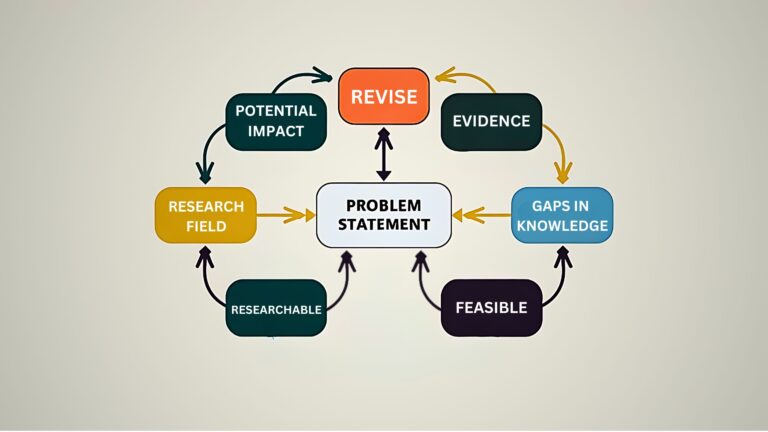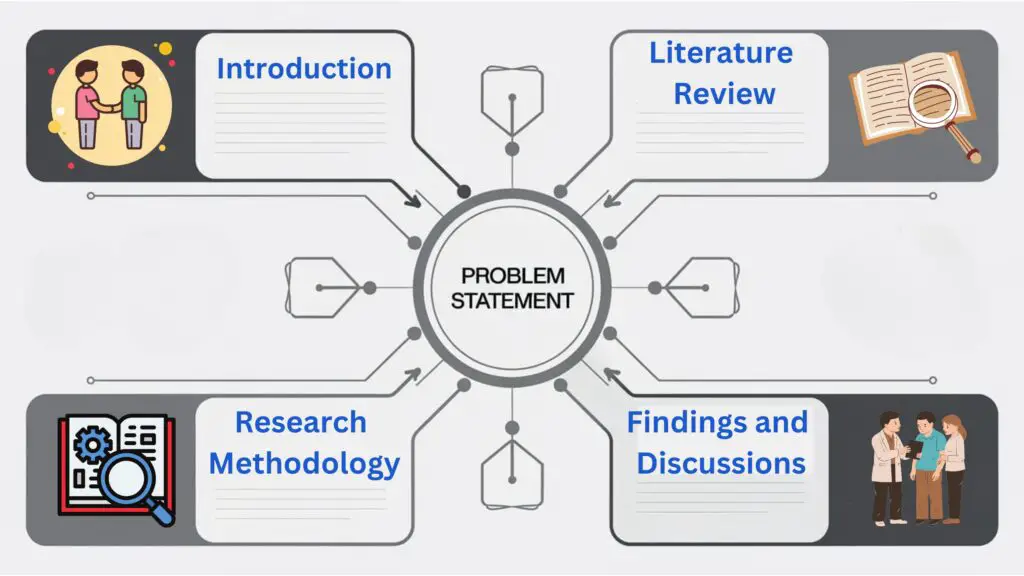Introduction
When research is inductive in nature then problem statement is to be written. It is generic explanation around area of work which highlights a problem that has not been investigated earlier or was overlooked. The purpose of the problem statement is to add new knowledge or clarify something in prior knowledge with a new approach.
Table of Contents
ToggleHow to Write a Problem Statement
A problem statement is generally composed of a single sentence but it has two parts e-g it can state a loss which have occurred followed by reason for the loss. Generally, it is a cause and effect-based statement.
A problem statement stating that there is a rise of pollution in London is not a complete problem statement as there is no effect in this statement, however if the effect of pollution is added in statement it will be complete problem statement. The rephrased problem statement as “Rise of pollution in London is causing lung diseases” is a valid problem statement. Moreover, problem statement must have research value, different reviews and opinions available.
Framework for writing a problem statement is given below:-
| Stages | Suggestion | Important Questions |
|---|---|---|
| Step 1 | Frame your problem | Is your statement cause and effect based? Is it researchable? Do you have enough time and resources available? |
| Step 2 | Find key words to discuss your problem | Do you have key words? Are keywords explained or elaborated enough in statement? Do you have supporting data available to back that this is a problem that can be researched? |
| Step 3 | Peel off or expand your approach | Are you connecting problem statement with research? Are you following writing conventions of Chicago in writing problem statement |
| Step 4 | Putt all things together. Support problem statement with references and reliable data | Do you have research worthy data? Is your problem statement connected to all sections of paper? |
Broad Contours of Problem Statement
The problem statement should be grounded in existing literature or evidence. It should demonstrate that the identified problem is based on a gap in current knowledge or an unresolved issue in the field. The problem statement may cite relevant studies, theories, or empirical evidence to support its claims and justify the need for further research. E-g in research paper on “Technology essentials for knowledgeable society”, problem statement should be based like that “there is need for digital literacy to harness the true dividends of technology” or “there is a need to inculcate technology essentials in diverse populations”. Each of problem statement must be supported by the fact the enough research gap exists in this domain.
Jones, Susan R., Vasti Torres, and Jan Arminio. Negotiating the complexities of qualitative research in higher education: Fundamental elements and issues. Routledge, 2013.
2. Feasible and Researchable:
A problem statement should be realistic and feasible in terms of the available resources, time constraints, and research methods. It should indicate that the problem can be effectively addressed through research and that the necessary data and information can be collected and analyzed. The problem statement should align with the research aims and objectives, indicating that it can be adequately explored within the study’s limitations.
Kothari, Chakravanti Rajagopalachari. Research methodology: Methods and techniques. New Age International, 2004.
3. Specific to the Research field:
The problem statement should consider the specific context and characteristics of the research field or discipline. It should demonstrate an understanding of the relevant theories, concepts, and methodologies associated with the field. The problem statement should be tailored to the specific research area, addressing the unique challenges and issues within that domain.
4. Having context and Background:
Briefly provide the necessary context and background information to help readers understand the problem. This may include citing relevant studies, statistics, or key findings from previous research. Make sure to explain why the problem is significant and how it relates to the broader field of study.
5. Highlight the Importance and Potential impact:
Clearly articulate the importance and potential impact of finding a solution to the problem. Explain how addressing the problem can contribute to knowledge advancement, practical applications, or theoretical developments in your field. Emphasize the relevance and significance of your research to garner support and interest from readers and potential funders.
6. Revise and refine:
Review and revise your problem statement multiple times to ensure clarity, precision, and coherence. Seek feedback from mentors, colleagues, or advisors to gain different perspectives and refine your statement further. Make sure that the problem statement aligns with the overall objectives and research plan outlined in your proposal.
The Linkage of Problem Statement with other Sections of research paper
It is important to keep other sections in mind while framing your problem statement. This definitely further aggravates the difficulty in writing problem statement. Defining a research problem statement that is consistent with the other sections in the dissertation increases the challenge. Considering that the problem statement is typically written at the beginning of the dissertation, it means the student has little knowledge of what is ahead, so looking ahead is going to be difficult. The brief explanation of how research problem effects other important parts is discussed in ensuing paragraphs.
1. Introduction/ Background:
In the introduction and background sections, the problem statement plays a vital role in setting the stage and establishing the context. It succinctly introduces the specific problem or research question, weaving it into the broader landscape of existing knowledge. Through a careful interplay of literature review and problem statement, the introduction provides a comprehensive overview of the problem’s significance, drawing readers into the paper’s narrative with a compelling rationale for further investigation. For instance, a problem statement exploring the effects of artificial intelligence on job automation would artfully align the introduction’s discussion of previous studies with the need to explore its implications in the contemporary workforce.
2. Literature Review:
Moving to the literature review, the problem statement serves as a guiding beacon that ensures focused and relevant exploration of the existing body of knowledge. It directs researchers to seek out studies, theories, and concepts directly connected to the problem at hand, guarding against tangents or irrelevant detours. By staying closely aligned with the problem statement, the literature review not only supports the rationale for the research but also creates a cohesive bridge between the existing knowledge and the proposed investigation.
3. Research Methodology:
When it comes to the methodology section, the problem statement exerts a profound influence on the research design and approach. It shapes the selection of appropriate methods, variables, and data collection techniques, ensuring that the research is tailored to address the identified problem effectively. For example, a problem statement investigating the impact of social media on self-esteem would steer researchers towards survey instruments and content analysis methods to capture relevant data. This alignment between the problem statement and the chosen methodology ensures that the research remains focused and purposeful throughout its execution.
4. Findings and Discussions:
As the research progresses, the problem statement continues to bind the different segments together, particularly in the results and discussion sections. The problem statement acts as a compass, guiding researchers to identify and present the most pertinent findings that directly relate to the problem at hand. It dictates which results should be highlighted and interpreted, enabling a nuanced analysis of their implications within the context of the identified problem. This strategic alignment ensures that the results and discussion remain tightly connected to the central research objective, reinforcing the paper’s coherence.
5. Conclusion:
Finally, in the conclusion, the problem statement resurfaces to tie all the threads together. It encapsulates the paper’s journey, summarizing how the research has addressed the problem and advanced knowledge in the field. The conclusion reflects on the significance of the findings within the framework of the problem statement, offering thought-provoking insights and suggestions for future research avenues that aim to further tackle the identified problem.
Conclusion
In essence, the problem statement serves as the backbone that unifies the different segments of a paper or report, elevating it to a higher intellectual level. Its seamless integration throughout the various sections ensures that the research remains focused, purposeful, and relevant, ultimately contributing to the advancement of knowledge and understanding within the field of study.




